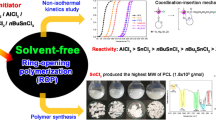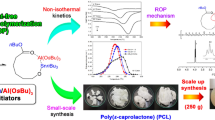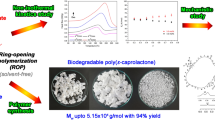Abstract
The n-butyltin(IV) trichloride (nBuSnCl3) initiator was successfully utilized in the ring-opening polymerization (ROP) of ε-caprolactone (ε-CL) under solvent-free conditions. Its reactivity was investigated by the non-isothermal differential scanning calorimetry (DSC). Effect of nBuSnCl3 concentration on the ROP of ε-CL was investigated by the Kissinger and model fitting methods. The obtained activation energy (Ea) values for the ROP of ε-CL with 1.0 mol% of nBuSnCl3 were higher than 2.0, and 4.0 mol%, respectively. Furthermore, the degree of aggregation (m) of nBuSnCl3 in the ROP of ε-CL was determined by the DSC technique. From the obtained m values at 120 and 140 °C, nBuSnCl3 presented in a non-aggregated state in the non-isothermal ROP of ε-CL. The performance of nBuSnCl3 was also compared with the di-n-butyltin(IV) dichloride (nBu2SnCl2) and tri-n-butytlin(IV) chloride (nBu3SnCl). The number of chloride and n-butyl groups adjacent to the Sn active center significantly affected the solvent-free ROP of ε-CL. From the non-isothermal DSC measurement, the polymerization exotherms for the ROP of ε-CL with nBuSnCl3 occurred and were completed at a lower temperature range than nBu2SnCl2, and nBu3SnCl, respectively. The Ea value for the ROP of ε-CL initiated by nBu3SnCl was higher than nBu2SnCl2, and nBuSnCl3, respectively. The values of pre-exponential factor (lnA) for the ROP of ε-CL initiated by nBu3SnCl, nBu2SnCl2, and nBuSnCl3 were determined from the first order reaction model fitting (f(α) = 1−α) and compensation effect. The kinetics data demonstrated that the reactivity of nBuSnCl3 was higher than nBu2SnCl2, and nBu3SnCl due to the lowest steric hindrance and the highest Lewis acidity of nBuSnCl3. Larger-scale (250 g) polymerization of ε-CL was preliminarily investigated by using the highly reactive nBuSnCl3 initiator. nBuSnCl3 could effectively produce PCL with weight average molecular weight (Mw) of 7.1 × 104 g/mol and 82% yield at 150 °C for 24 h. The probable mechanism of the ROP of ε-CL with nBu3SnCl was proposed via the coordination-insertion mechanism.
Graphical abstract












Similar content being viewed by others
References
Mecerreyes D, Jérôme R, Dubois P (1999) Novel macromolecular architectures based on aliphatic polyesters: relevance of the coordination-insertion ring-opening polymerization. Adv Polym Sci 147:1–59
Stridsberg KM, Ryner M, Albertsson AC (2002) Controlled ring-opening polymerization: polymers with designed macromolecular architecture. Adv Polym Sci 157:41–65
Cabaret OD, Vaca BM, Bourissor D (2004) Controlled ring-opening polymerization of lactide and glycolide. Chem Rev 104:6147–6176
Tian H, Tang Z, Zhuang X, Chen X, Jing X (2012) Biodegradable synthetic polymers: preparation, functionalization and biomedical application. Prog Polym Sci 37:237–280
Kowalski A, Duda A, Penczek S (1998) Kinetics and mechanism of cyclic esters polymerization initiated with tin(II) octoate, 1. Polymerization of ε-caprolactone. Macromolecules 19:567–572
Limwanich W, Khunmanee S, Kungwan N, Punyodom W, Meepowpan P (2015) Effect of tributyltin alkoxides chain length on the ring-opening polymerization of ϵ-caprolactone: kinetics studies by non-isothermal DSC. Thermo Chim Acta 599:1–7
Kricheldorf HR, Weidner SM (2020) High molar mass cyclic poly(L-lactide) obtained by means of neat tin(II) 2-ethylhexanoate. Polym Chem 11:5249–5260
Kowalski A, Libiszowski J, Duda A, Penczek S (2000) Polymerization of L,L-dilactide initiated by tin(II) butoxide. Macromolecules 33:1964–1971
Kaihara S, Matsumura S, Mikos AG, Fisher JP (2007) Synthesis of poly(L-lactide) and polyglycolide by ring-opening polymerization. Nat Protoc 2:2767–2771
Dutta S, Hung WC, Huang BH, Lin CC (2012) Recent developments in metal-catalyzed ring-opening polymerization of lactides and glycolides: preparation of polylactides, polyglycolide, and poly(lactide-co-glycolide). Adv Polym Sci 245:219–284
Garner J, Skidmore S, Park, Park K, Choi S, Wang Y (2015) A protocol for assay of poly(lactide-co-glycolide) in clinical products. Int J Pharm 495:87–92
Chen Y, Yang Z, Liu C, Wang C, Zhao S, Yang J, Sun H, Zhang Z, Kong D, Song C (2013) Synthesis, characterization, and evaluation of paclitaxel loaded in six-arm star-shaped poly(lactic-co-glycolic acid). Int J Nanomed 8:4315–4326
Kricheldorf HR, Bornohorst K, Thiessen HH (2005) Bismuth(III) n-hexanoate and tin(II) 2-ethylhexanoate initiated copolymerizations of ε-caprolactone and l-lactide. Macromolecules 38:5017–5024
Sriyai M, Tasati J, Molloy R, Meepowpan P, Somsunan R, Worajittiphon P, Daranarong D, Punyodom W (2021) Development of an antimicrobial-coated absorbable monofilament suture from a medical-grade poly(l-lactide-co-ε-caprolactone) copolymer. ACS Omega 6:28788–28803
Baimark Y, Molloy R, Molloy N, Siripitayananon J, Punyodom W, Sriyai M (2005) Synthesis, characterization and melt spinning of a block copolymer of L-lactide and ε-caprolactone for potential use as an absorbable monofilament surgical suture. J Mater Sci Mater Med 16:699–707
Kricheldorf HR, Sumbel MV, Saunders IK (1991) Polylactones. 20. Polymerization of ε-caprolactone with tributyltin derivatives: a mechanistic study. Macromolecules 24:1944–1949
Deshayes G, Mercier FAG, Degee P, Verbruggen I, Biesemans M, Willem R, Dubois P (2003) Mechanistic study of Bu2SnCl2-mediated ring-opening polymerization of ε-caprolactone by multinuclear NMR spectroscopy. Chem Eur J 9:4346–4352
Meelua W, Molloy R, Meepowpan P, Punyodom W (2012) Isoconversional kinetic analysis of ring-opening polymerization of ε-caprolactone: steric influence of titanium(IV) alkoxides as initiators. J Polym Res 19:9799
Limwanich W, Meelua W, Meepowpan P, Punyodom W (2022) Kinetics and thermodynamics studies of the ring-opening polymerization of ε-caprolactone initiated by titanium(IV) alkoxides by isothermal differential scanning calorimetry. React Kinet Mech Catl 135:881–895
Sattayanon C, Sontising W, Limwanich W, Meepowpan P, Punyodom W, Kungwan N (2015) Effects of alkoxide alteration on the ring-opening polymerization of ε-caprolactone initiated by n-Bu3SnOR: a DFT study. Struct Chem 26:695–703
Limwanich W, Meepowpan P, Kungwan N, Punyodom W (2020) Influence of butyl group of tin chloride initiators on the non-isothermal DSC ring-opening polymerization of ε-caprolactone: the studies of kinetics, mechanism and polymer synthesis. Thermochim Acta 683:178458
Punyodom W, Thapsukhon B, Meepowpan P, Limwanich W (2022) Dibutyltin(IV) maleate as a new effective initiator for the ring-opening polymerization of ε-caprolactone: the non-isothermal kinetics, mechanism, and initiator’s performance in polymer synthesis. Polym Bull. https://doi.org/10.1007/s00289-022-04234-x
Punyodom W, Meepowpan P, Limwanich W (2022) Determination of the activation parameters for the ring-opening polymerization of ε-caprolactone initiated by Sn(II) and zn(II) chlorides using the fast technique of DSC. Thermochim Acta 710:179160
Punyodom W, Limwanich W, Meepowpan P (2017) Tin(II) n-butyl l-lactate as novel initiator for the ring-opening polymerization of ε-caprolactone: kinetics and aggregation equilibrium analysis by non-isothermal DSC. Thermochim Acta 655:337–343
Vyazovkin S, Burnham AK, Criado JM, Perez-Maqueda LA, Popescu C, Sbirrazzuoli N (2011) ICTAC kinetics committee recommendations for performing kinetic computations on thermal analysis data. J Thermochim Acta 520:1–19
Kissinger HE (1957) Reaction kinetics in differential thermal analysis. Anal Chem 29:1702–1706
Punyodom W, Meepowpan P, Thapsukhon B, Dumklang M, Limwanich W (2022) Investigation of the initiating and catalytic behavior of tri-n-butyltin(IV) n-butoxide in ring-opening polymerization of ε-caprolactone and transesterification of poly(L-lactic acid). Chiang Mai J Sci 49(1):27–38
Hernandez AR, Richa AM (2010) Ring opening polymerization of ε-caprolactone initiated by decamolybdate anion: determination of kinetic and thermodynamic parameters by DSC and 1H-NMR. J Appl Polym Sci 115:2288–2295
Li P, Zerroukhi A, Chen J, Chalamet Y, Jeanmaire T, Xia Z (2008) Kinetics study of Ti [O(CH2)4OCHCH2]4 initiated ring-opening polymerization of ε-caprolactone by differential scanning calorimetry. J Appl Polym Sci 110:3990–3998
Vyazovkin S, Achilias D, Fernandez-Francos X, Galukhin A, Sbirrazzuoli N (2022) ICTAC kinetics committee recommendations for analysis of thermal polymerization kinetics. Thermochim Acta 714:179243
Penczek S, Cypryk M, Duda A, Kubisa P, Slomkowski S (2007) Living ring-opening polymerizations of heterocyclic monomers. Prog Polym Sci 32:247–282
Limwanich W, Meepowpan P, Nalampang K, Kungwan N, Molloy R, Punyodom W (2015) Kinetics and thermodynamics analysis for ring-opening polymerization of ε-caprolactone initiated by tributyltin n-butoxide using differential scanning calorimetry. J Therm Anal Calorim 119:567–679
Duda A, Penczek S (1991) Kinetics of ε-caprolactone polymerization on dialkylaluminumalkoxides. Makromol Chem Macromol Symp 47:127–140
Duda A, Penczek S (1994) Kinetics of polymerization involving reversible deactivation due to aggregation of active centers. Analytical vs. numerical solution for the ε-caprolactone/dialkylaluminumalkoxide system. Macromol Rapid Commun 15:559–566
Kricheldorf HR, Thießen HH (2004) Polylactones 60: comparison of the reactivity of Bu3SnOEt, Bu2Sn(OEt)2, and BuSn(OEt)3 as initiators of ε-caprolactone. J Macromol Sci A A41(4):335–343
Limwanich W, Phetsuk S, Meepowpan P, Kungwan N, Punyodom W (2016) Kinetics studies of non-isothermal melt crystallization of poly(ε-caprolactone) and poly(Llactide). Chiang Mai J Sci 43:329–338
Nakagawa S, Kadena K, Ishizone T, Nojima S, Shimizu T, Yamaguchi K, Nakahama S (2012) Crystallization behavior and crystal orientation of poly (ε-caprolactone) homopolymers confined in nanocylinders: effects of nanocylinder dimension. Macromolecules 45:1892–1900
Munoz-Bonilla A, Cerrada ML, Fernandez-García M, Kubacka A, Ferrer M, Fernandez-García M (2013) Biodegradable polycaprolactone-titania nanocomposites: preparation, characterization and antimicrobial properties. Int J Mol Sci 14:9249–9266
Funfuenha W, Punyodom W, Meepowpan P, Limwanich W (2023) Microwaveassisted solventfree ringopening polymerization of εcaprolactone initiated by nbutyltin(IV) chlorides. Polym Bull. https://doi.org/10.1007/s00289-023-04720-w
Limwanich W, Rakbamrung N, Meepowpan P, Funfuenha W, Kongsuk J, Punyodom W (2023) Solventfree ringopening polymerization of εcaprolactone initiated by mg(II), sn(II), zn(II), Al(III), and Sn(IV) derivatives: a comparative study. React Kinet Mech Catal 136:381–395
Punyodom W, Meepowpan P, Girdthep S, Limwanich W (2022) Influence of tin(II), aluminum(III) and titanium(IV) catalysts on the transesterification of poly(L-lactic acid). Polym Bull. https://doi.org/10.1007/s00289-021-04005-0
Albertsson AC, Varma IK (2003) Recent developments in ring opening polymerization of lactones for biomedical applications. Biomacromol 4:1466–1486
Acknowledgements
This research project was supported by Fundamental Fund 2024 (grant number FF2567P004), Rajamangala University of Technology Lanna (W. Limwanich). This research work was partially supported by Chiang Mai University. We also would like to thank the Center of Excellence in Materials Science and Technology for partial support. We also thank the Faculty of Science and Agricultural Technology for the support of the DSC analysis.
Author information
Authors and Affiliations
Contributions
W.L. was the principal investigator of this research project, performed the DSC kinetics study, caluculated the kinetic parameters, designed the synthesis process of PCL, and drafted the manuscript.B.T. analyzed the obtained kinetic results and characterized the obtained PCL.P.M. proposed the polymerization mechanism and characterized the PCL structure by the NMR technique.W.F. synthesized PCL at different conditions.M.D. analyzed the obtained kinetics results and discussed them.S.T. synthesized PCL at different conditions.W.P. analyzed the obtained GPC results and checked the suitability of the drafted manuscript. All authors reviewed the manuscript.
Corresponding author
Ethics declarations
Conflict of interest
The authors declare that they have no known competing financial interests or personal relationships that could have appeared to influence the work reported in this paper.
Additional information
Publisher’s Note
Springer Nature remains neutral with regard to jurisdictional claims in published maps and institutional affiliations.
Rights and permissions
Springer Nature or its licensor (e.g. a society or other partner) holds exclusive rights to this article under a publishing agreement with the author(s) or other rightsholder(s); author self-archiving of the accepted manuscript version of this article is solely governed by the terms of such publishing agreement and applicable law.
About this article
Cite this article
Limwanich, W., Thapsukhon, B., Meepowpan, P. et al. n-Butyltin(IV) trichloride initiator for the solvent-free ring-opening polymerization of ε-caprolactone: evaluation of the structure-reactivity relationship of tin(IV) derivatives. Polym. Bull. (2024). https://doi.org/10.1007/s00289-024-05310-0
Received:
Revised:
Accepted:
Published:
DOI: https://doi.org/10.1007/s00289-024-05310-0




